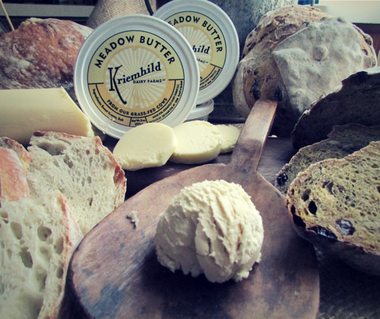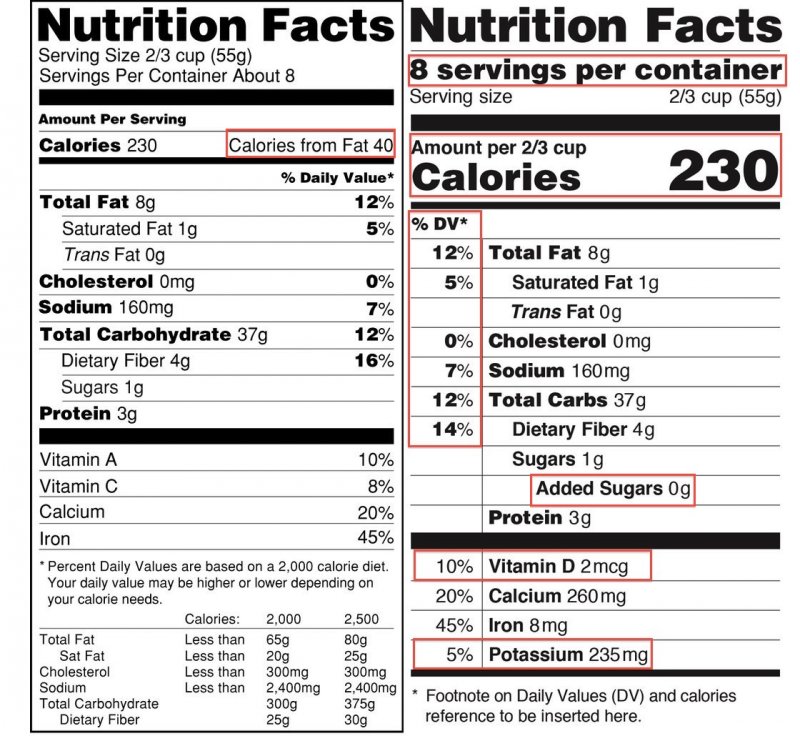When Being Yellow Bellied is a Good Thing…We love the first day of butter making. There’s nothing like churning the first cream of the season into a 1200 pound mountain of smooth, lightly salted, very yellow butter. As we take a ceremonial first taste, we have to ask: why is spring butter so magical? Milk is a complex mixture of fat, proteins, carbohydrates, minerals, vitamins and other miscellaneous constituents dispersed in water. Yet, the amount of these components vary based on the cow’s diet, the breed of cow, and a cow’s stage of lactation. Being a seasonal, grass-fed dairy is reflected in how our butter tastes and also how it changes over the course of the grazing season. Spring butter has an unmistakable yellow glow. This color is affected by the increased amount of fresh grass in the cows’ diet during the spring as they start grazing. Fresh forage is bountiful in carotenoids, classes of mainly yellow, orange, or red fat-soluble pigments, which then manifests in our high fat butter. When ingested by a cow, one carotenoid in particular, beta-carotene, is converted to vitamin A. This results in a butter with a higher vitamin A content in the spring. Winter butter is produced primarily when the cows are on stored feed such as hay and hay ferment, so it is paler in comparison. If you don’t notice a huge change of color in our butter, it’s ok. Many of the cows that produce our butter are mixes of breeds that naturally produce milk with a higher carotene content regardless of the season (i.e. Jerseys and Guernseys). Also, very often the cows at Red Gate Farm are grazing fresh forage well into November, and don’t stop milking until December. So, there is a small window in which we are creating “winter butter” from a mix of fresh forage and stored forage. Because of all of these variables, the color shift over the grazing season is subtle, gradual and not at all linear. More than just the color, the texture of Meadow Butter changes over the season as well. Spring butter is perfectly spreadable, if not slightly leaky, while winter butter can be firmer, even appear to be somewhat brittle. This change reflects the saturation of milk fat in the butter. The presence of longer-chain saturated fatty acids increases the hardness of butter. Milk with a high proportion of unsaturated fatty acid content tends to create softer, runnier products. During their outdoor grazing period, our cows’ milk is composed of lower saturated fatty acids and higher unsaturated fatty acid concentrations. During the winter, when the herd is fed stored forage, the reverse is true and our cream contains more saturated fats and less unsaturated fats. Saturated fat molecules are more uniform, and they form crystal structures more readily than unsaturated fats. These fat crystals yield a firmer product with a higher melting point. Many bakers consider the firmness of winter butter better for baking, finding that it makes it easier to work into a dough and bakes into perfect flaky pastries and crusts. One final variable that affects Meadow Butter is you. Since, our butter can be frozen without compromising its taste or texture, if you choose to squirrel some away for the winter, then you can enjoy spring butter year-round. In fact, at Kriemhild we store our butter reserves in a commercial freezer between packing and farmer’s markets or wholesale shipments. This storability is also why we attempt to reserve enough to bridge the winter off-season, though (as our regular customers know) demand has historically outpaced our rate of butter-bank deposits -- which is another reason why we “run out” each winter. Although we at Kriemhild Dairy rejoice the arrival of our spring butter, we celebrate the seasonal variation in dairy. With its cycles, subtleties, ebbs, and flows, we embrace all the nuance that seasonal dairy brings -- yes, even the off-season. After all, absence makes the heart grow fonder (and hungrier), and experiencing seasonality garners true appreciation for the natural rhythms of our food system.
0 Comments
Remember when fat became bad, and then it wasn't?A hallmark of reason is that opinions change when new information gives good cause. The truth is that habits and social inertia are a bit harder to change. This dichotomy could not be better illustrated than thru the American nutritional relationship with dietary fats. Now, changes to ubiquitous food labeling are helping support a known shift in perspective on fats in our food.
If you buy packaged foods, like many Americans you are intimately familiar with the Nutrition Facts Label. You know, that minimalistic black-and-white label on the side or back of more than 6.5 billion food packages; the stark info table above the ingredients list that doesn’t judge your food choices, but neither does it hide the truth about your foods’ salt and sugar content. Although instantly recognizable to us all, the Nutrition Facts label is only 20 years young. Per recommendation of the FDA, The label was born in 1990 under provision of the Nutrition and Labeling and Education Act, and it has remained essentially unchanged since then. From that perspective, 20 years is a long time for something to go unchanged or without revision. The FDA announced dramatic changes to the Nutrition facts label layout in 2016, and will be requiring it on packaged foods next year. It may appear much the same as it does today, but we’re awfully excited about the details of the new label. The label has always been used to direct consumers focus to the nutritional components of a food that bear the most significance on their health. Since the changes are based on recent scientific research and updated public health information, the label has been modified to shift that focus elsewhere. For example, “Total Fat,” “Saturated Fat,” and “Trans Fat” will remain on the label but “Calories from Fat” is being removed. Despite conventional (and outdated) dietary advice, research has shown that fat is not linked to the chronic nutritional diseases such as obesity, heart disease, and diabetes. It is more important to know what type of fat is in a food than how much of its energy content fat contributes (1,2) This is very vindicating for Kriemhild, being we are bringers of full-fat dairy. A serving of our Crème Fraîche provides 100 delicious, filling calories, and we’ve listened to many-a-customer gush with guilt they need not feel when they realize that all 100 of those calories are from fat (wholesome & beneficial fat, but fat none the less). Though food producers originally had been mandated to put ‘calories from fat’ on their packaging to encourage consumers to move towards low-fat diets, nutrition science has since found overwhelming evidence supporting the health benefits of good fat in our diets. Although there is a growing body of scientific evidence over the last decade to debunk the “fat makes you fat” myth, the ‘calories from fat’ still acts as a scarlet letter marking our Nutrition Labels and infecting our conscience; and so this guilt-trigger remains for many of us. Ideally, it’s removal will encourage the public to embrace healthy fats like those from grass fed or grass grazed dairy. Instead of demonizing fat, the new Nutritional Facts label will shine a light on the real culprit of an unhealthy diet: added sugar. ‘Added sugar’ was not originally added to the original nutritional facts label because (at that time) the FDA stated that the body made no physiological distinction between added and naturally occurring sugars. This has old stance has since been proven false (1,2) On the new label ‘Added sugar’ will be nested under total sugar. This way, after a little math, you can determine how much sugar in your food is natural sugar, like lactose in milk, and how much is added by the producer (1). Many low-fat or fat-free foods, especially dairy, claim to be healthier that their full-fat counterparts when in fact they typically have large amounts of added sugar to improve the taste and thickeners to simulate the texture of the full-fat version. We are proud to say that this more transparent labeling practice will only further underscore the wholesome makeup of our grass-based dairy (being added sugar and stabilizer free) and empower you to compare the facts on sugar content between your selections at the store. There are more differences between the original and second generation of our familiar Nutrition Facts label, and we encourage you to learn more about them here. It is one of Kriemhild's virtues to be transparent, and we feel that information is empowering to our customers. We’d love to hear your thoughts about this new Nutrition Facts label. Do you feel these changes better equip you to make healthy choices? Did grandma have it right, resisting the low-fat movement thru the last few decades? Let us know in the comments below, or on social media. Sources:
|
As the Butter Churns
Author: Ellen Fagan and Victoria PeilaCategories
All
Archives
November 2019
|
Where our HEart is
|
FOLLOW US |
what our customers are saying"Thank you! Even though I'm 5 hours away...I can't live without you. Got my shipment today.
#kriemhildbutterlove" -- Jennifer in Mystic, Connecticut |
Copyright 2020 © Kriemhild Dairy Farms, LLC







 RSS Feed
RSS Feed